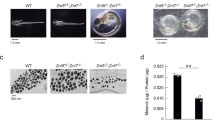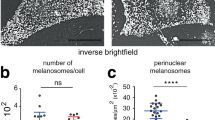Abstract
Iron is an essential element in many biological processes. In vertebrates, serum transferrin is the major supplier of iron to tissues, but the function of additional transferrin-like proteins remains poorly understood. Melanotransferrin (MTf) is a phylogenetically conserved, iron-binding epithelial protein. Elevated MTf levels have been implicated in melanoma pathogenesis. Here, we present a functional analysis of MTf in Drosophila melanogaster. Similarly to its human homologue, Drosophila MTf is a lipid-modified, iron-binding protein attached to epithelial cell membranes, and is a component of the septate junctions that form the paracellular permeability barrier in epithelial tissues. We demonstrate that septate junction assembly during epithelial maturation relies on endocytosis and apicolateral recycling of iron-bound MTf. Mouse MTf complements the defects of Drosophila MTf mutants. Drosophila provides the first genetic model for the functional dissection of MTf in epithelial junction assembly and morphogenesis.
This is a preview of subscription content, access via your institution
Access options
Subscribe to this journal
Receive 12 print issues and online access
$209.00 per year
only $17.42 per issue
Buy this article
- Purchase on Springer Link
- Instant access to full article PDF
Prices may be subject to local taxes which are calculated during checkout





Similar content being viewed by others
References
Farquhar, M. G. & Palade, G. E. Junctional complexes in various epithelia. J. Cell Biol. 17, 375–412 (1963).
Tepass, U. & Hartenstein, V. The development of cellular junctions in the Drosophila embryo. Dev. Biol. 161, 563–596 (1994).
Krupinski, T. & Beitel, G. J. Unexpected roles of the Na-K-ATPase and other ion transporters in cell junctions and tubulogenesis. Physiology 24, 192–201 (2009).
Banerjee, S., Sousa, A. D. & Bhat, M. A. Organization and function of septate junctions: an evolutionary perspective. Cell Biochem. Biophys. 46, 65–77 (2006).
Laprise, P. et al. Yurt, Coracle, Neurexin IV and the Na+, K+-ATPase form a novel group of epithelial polarity proteins. Nature 459, 1141–1145 (2009).
Genova, J. L. & Fehon, R. G. Neuroglian, Gliotactin, and the Na+/K+ ATPase are essential for septate junction function in Drosophila. J. Cell Biol. 161, 979–989 (2003).
Laprise, P. et al. Epithelial polarity proteins regulate Drosophila tracheal tube size in parallel to the luminal matrix pathway. Curr. Biol. 20, 55–61 (2009).
Suryo Rahmanto, Y., Dunn, L. L. & Richardson, D. R. The melanoma tumor antigen, melanotransferrin (p97): a 25-year hallmark—from iron metabolism to tumorigenesis. Oncogene 26, 6113–6124 (2007).
Alemany, R. et al. Glycosyl phosphatidylinositol membrane anchoring of melanotransferrin (p97): apical compartmentalization in intestinal epithelial cells. J. Cell Sci. 104, 1155–1162 (1993).
Demeule, M. et al. Regulation of plasminogen activation: a role for melanotransferrin (p97) in cell migration. Blood 102, 1723–1731 (2003).
Sekyere, E. O., Dunn, L. L., Rahmanto, Y. S. & Richardson, D. R. Role of melanotransferrin in iron metabolism: studies using targeted gene disruption in vivo. Blood 107, 2599–2601 (2006).
Rahmanto, Y. S. & Richardson, D. R. Generation and characterization of transgenic mice hyper-expressing melanoma tumour antigen p97 (Melanotransferrin): no overt alteration in phenotype. Biochim. Biophys. Acta 1793, 1210–1217 (2009).
Tomancak, P. et al. Systematic determination of patterns of gene expression during Drosophila embryogenesis. Genome Biol. 3, research0088–0088.14 (2002).
Wang, S. et al. Septate-junction-dependent luminal deposition of chitin deacetylases restricts tube elongation in the Drosophila trachea. Curr. Biol. 16, 180–185 (2006).
Lamb, R. S., Ward, R. E., Schweizer, L. & Fehon, R. G. Drosophila coracle, a member of the protein 4.1 superfamily, has essential structural functions in the septate junctions and developmental functions in embryonic and adult epithelial cells. Mol. Biol. Cell. 9, 3505–3519 (1998).
Baumgartner, S. et al. A Drosophila neurexin is required for septate junction and blood-nerve barrier formation and function. Cell 87, 1059–1068 (1996).
Fehon, R. G., Dawson, I. A. & Artavanis-Tsakonas, S. A Drosophila homologue of membrane-skeleton protein 4.1 is associated with septate junctions and is encoded by the coracle gene. Development 120, 545–557 (1994).
Woods, D. F. & Bryant, P. J. The discs-large tumor suppressor gene of Drosophila encodes a guanylate kinase homolog localized at septate junctions. Cell 66, 451–464 (1991).
Hemphala, J., Uv, A., Cantera, R., Bray, S. & Samakovlis, C. Grainy head controls apical membrane growth and tube elongation in response to Branchless/FGF signalling. Development 130, 249–258 (2003).
Paul, S. M., Ternet, M., Salvaterra, P. M. & Beitel, G. J. The Na+/K+ ATPase is required for septate junction function and epithelial tube-size control in the Drosophila tracheal system. Development 130, 4963–4974 (2003).
Faivre-Sarrailh, C. et al. Drosophila contactin, a homolog of vertebrate contactin, is required for septate junction organization and paracellular barrier function. Development 131, 4931–4942 (2004).
Wucherpfennig, T., Wilsch-Brauninger, M. & Gonzalez-Gaitan, M. Role of Drosophila Rab5 during endosomal trafficking at the synapse and evoked neurotransmitter release. J. Cell Biol. 161, 609–624 (2003).
Emery, G. et al. Asymmetric Rab 11 endosomes regulate delta recycling and specify cell fate in the Drosophila nervous system. Cell 122, 763–773 (2005).
Laval, M., Bel, C. & Faivre-Sarrailh, C. The lateral mobility of cell adhesion molecules is highly restricted at septate junctions in Drosophila. BMC Cell Biol. 9, 38 (2008).
Leibfried, A., Fricke, R., Morgan, M. J., Bogdan, S. & Bellaiche, Y. Drosophila Cip4 and WASp define a branch of the Cdc42–Par6–aPKC pathway regulating E-cadherin endocytosis. Curr. Biol. 18, 1639–1648 (2008).
Georgiou, M., Marinari, E., Burden, J. & Baum, B. Cdc42, Par6 and aPKC regulate Arp2/3-mediated endocytosis to control local adherens junction stability. Curr. Biol. 18, 1631–1638 (2008).
Shaye, D. D., Casanova, J. & Llimargas, M. Modulation of intracellular trafficking regulates cell intercalation in the Drosophila trachea. Nat. Cell Biol. 10, 964–970 (2008).
Tsarouhas, V. et al. Sequential pulses of apical epithelial secretion and endocytosis drive airway maturation in Drosophila. Dev. Cell 13, 214–225 (2007).
Cerezo, J. R., Jimenez, F. & Moya, F. Characterization and gene cloning of Drosophila syntaxin 1 (Dsynt1): the fruit fly homologue of rat syntaxin 1. Brain Res. Mol. Brain Res. 29, 245–252 (1995).
Moussian, B. et al. Drosophila Knickkopf and Retroactive are needed for epithelial tube growth and cuticle differentiation through their specific requirement for chitin filament organization. Development 133, 163–171 (2006).
He, Q. Y. et al. Inequivalence of the two tyrosine ligands in the N-lobe of human serum transferrin. Biochemistry 36, 14853–14860 (1997).
Mason, A. B. et al. Mutational analysis of C-lobe ligands of human serum transferrin: insights into the mechanism of iron release. Biochemistry 44, 8013–8021 (2005).
Lambert, L. A., Perri, H., Halbrooks, P. J. & Mason, A. B. Evolution of the transferrin family: conservation of residues associated with iron and anion binding. Comp. Biochem. Physiol. B, Biochem. Mol. Biol. 142, 129–141 (2005).
Farnaud, S. et al. Biochemical and spectroscopic studies of human melanotransferrin (MTf): electron-paramagnetic resonance evidence for a difference between the iron-binding site of MTf and other transferrins. Int. J. Biochem. Cell Biol. 40, 2739–2745 (2008).
Hentze, M. W., Muckenthaler, M. U. & Andrews, N. C. Balancing acts: molecular control of mammalian iron metabolism. Cell 117, 285–297 (2004).
Spradling, A. C. et al. The Berkeley Drosophila Genome Project gene disruption project: Single P-element insertions mutating 25% of vital Drosophila genes. Genetics 153, 135–177 (1999).
Entchev, E. V., Schwabedissen, A. & Gonzalez-Gaitan, M. Gradient formation of the TGF-β homolog Dpp. Cell 103, 981–991 (2000).
Li, B. X., Satoh, A. K. & Ready, D. F. Myosin V, Rab11, and dRip11 direct apical secretion and cellular morphogenesis in developing Drosophila photoreceptors. J. Cell Biol. 177, 659–669 (2007).
Lee, T. & Luo, L. Mosaic analysis with a repressible cell marker for studies of gene function in neuronal morphogenesis. Neuron 22, 451–461 (1999).
Eisenhaber, B., Bork, P. & Eisenhaber, F. Prediction of potential GPI-modification sites in proprotein sequences. J. Mol. Biol. 292, 741–758 (1999).
Bieber, A. J. et al. Drosophila neuroglian: a member of the immunoglobulin superfamily with extensive homology to the vertebrate neural adhesion molecule L1. Cell 59, 447–460 (1989).
Wu, V. M., Schulte, J., Hirschi, A., Tepass, U. & Beitel, G. J. Sinuous is a Drosophila claudin required for septate junction organization and epithelial tube size control. J. Cell Biol. 164, 313–323 (2004).
Venema, D. R., Zeev-Ben-Mordehai, T. & Auld, V. J. Transient apical polarization of Gliotactin and Coracle is required for parallel alignment of wing hairs in Drosophila. Dev. Biol. 275, 301–314 (2004).
Kuraishi, T. et al. Identification of calreticulin as a marker for phagocytosis of apoptotic cells in Drosophila. Exp. Cell Res. 313, 500–510 (2007).
Missirlis, F. et al. Characterization of mitochondrial ferritin in Drosophila. Proc. Natl Acad. Sci. USA 103, 5893–5898 (2006).
Acknowledgements
We are indebted to S. Baumgartner, M. González-Gaitán, R. Fehon, G. Beitel, M. Bhat, F. Missirlis, H. Bellen, M. Hortsch, D. Ready, V. Auld, the Bloomington Drosophila Stock Center, the Drosophila Genomics Resource Center (DGRC; Indiana), and the Developmental Studies Hybridoma Bank (DSHB; Iowa) for Drosophila strains, clones and antibodies. We thank M. Sahlin for initial help with iron detection, T. Astlind for the EPR measurements and M. Björk and I. Granell for expert technical assistance. We are grateful to members of the Samakovlis lab for suggestions. K.S. was supported by an EMBO postdoctoral fellowship. The work was supported by grants from the G. Gustafsson Foundation, Vetenskapsrådet and Cancerfonden to C.S.
Author information
Authors and Affiliations
Contributions
C.S., K.S. and K.T. designed the experiments. K.T. performed the experiments. S.W. identified the tracheal overelongation phenotype of the MTf P-element mutant. A.G. analysed the EPR data. C.S., K.T. and K.S. wrote the paper.
Corresponding author
Ethics declarations
Competing interests
The authors declare no competing financial interests.
Supplementary information
Supplementary Information
Supplementary Information (PDF 1921 kb)
Rights and permissions
About this article
Cite this article
Tiklová, K., Senti, KA., Wang, S. et al. Epithelial septate junction assembly relies on melanotransferrin iron binding and endocytosis in Drosophila. Nat Cell Biol 12, 1071–1077 (2010). https://doi.org/10.1038/ncb2111
Received:
Accepted:
Published:
Issue Date:
DOI: https://doi.org/10.1038/ncb2111
This article is cited by
-
Rab11 negatively regulates wingless preventing JNK-mediated apoptosis in Drosophila epithelium during embryonic dorsal closure
Cell and Tissue Research (2023)
-
The membrane-bound and soluble form of melanotransferrin function independently in the diagnosis and targeted therapy of lung cancer
Cell Death & Disease (2020)
-
Glycosylhydrolase genes control respiratory tubes sizes and airway stability
Scientific Reports (2020)
-
The Caspase-3 homolog DrICE regulates endocytic trafficking during Drosophila tracheal morphogenesis
Nature Communications (2019)
-
WASH phosphorylation balances endosomal versus cortical actin network integrities during epithelial morphogenesis
Nature Communications (2019)



